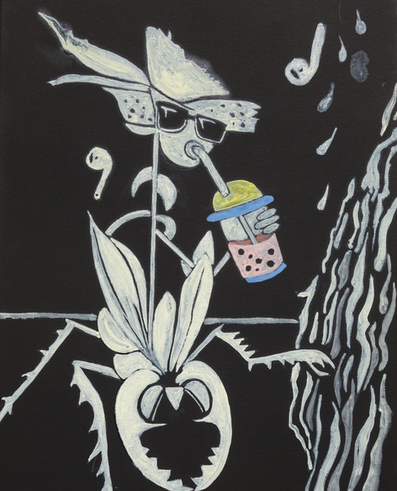ARQUIVOS PRECÁRIOS DA MEMÓRIA
ARQUIVOS PRECÁRIOS DA MEMÓRIA
YEAR: 2025-2026
EXHIBITION VIEW: Centro de Arte Contemporânea Quinta da Cruz, Viseu,Portugal
DATE: 30.09.2025 -15.01.2026
PHOTOCREDITS: © Ruth Mateus-Berr

DESCRIPTION
TITLE: ARQUIVOS PRECÁRIOS DA MEMÓRIA
FORMAT: various
TECHNIQUE: oilpainting / Aquarell
MATERIAL: canvas / paper
Florilegia comprise three distinct series: Rare Plants (oil painting), Floral Nostalgia with Attitude (oil painting), and Colonial Context (watercolor). Since the Renaissance, pictorial florilegia have been much more than compendiums of natural history. These magnificent books on plants combined scientific precision, medical/pharmaceutical knowledge, and artistic creation in a veritable “flower harvest” of nature and culture. They documented botanical diversity, served teaching and research purposes, but were also signs of erudition and social status. In their dual function as reservoirs of knowledge and objects of representation, they staged the plant simultaneously as precious beauty and as a symbol of transience. Today, the principle of the anthology is undergoing a new shift: it is no longer the abundance and order of nature that occupy the center, but rather its fragility. In this work, endangered plant species appear in the foreground—represented in the colors they take on when, in the process of dying, they no longer produce chlorophyll. These representations appear as contemporary memento mori, as markers of the finitude and vulnerability of plant life. At the same time, some intensely colorful visual references in the exhibition revisit the tradition of Dutch painting.
Still life, which emerged in the 16th and 17th centuries as an expression of artistic virtuosity and simultaneously as a symbol of Vanitas, is not only a formal reference here, but also a space of historical resonance.
Still lifes from this period demonstrated wealth and abundance, displaying imported fruits, exotic flowers, and precious goods—thus inextricably linked to the commercial networks and power structures of colonization. Equally significant was the portrait painting of the time, which staged the individual in a representative pose, making visible identity, social position, and ideals of virtue. Portraits served as an expression of personal presence and social status, often enriched by symbols, clothing, and accessories that illustrated origin, education, or power. Cycle of works: Anthologies / series of paintings: Colonial Context In this regard, the exhibition opens up a series of spaces for association. The Portrait of a Young Lady (c. 1470) by Petrus Christus appears in a new form as “Senhora de Verde” (“Lady in Green”) adorned with the endangered Antirrhinum lopesianum (Dragon-of-the-Cliffs, Plantaginaceae) from Portugal, from which the equally endangered Onosma tricerosperma subsp. tricerosperma sprouts from her hat. A necklace references the meme of Inosuke Brendon's scream, thus linking the historical model to a reference to digital visual culture. The figure is complemented by a plant brooch that refers to Anadenanthera colubrina (Leguminosae), a species native to a former Dutch, later Portuguese, colony in Brazil, which only blooms in the dry season.
These interconnections between plant, image, and symbol open our eyes to the responsibilities of yesterday and today: to nature, to the cultural attributions of meaning, and to confronting colonial history. Here, the anthologies become open image archives that relate past and present, memory and warning at the same time. Another example is the work inspired by Franz Hals (1580–1666): Young Man with a Skull in His Hand, Vanitas (1626–1628), from whose hat sprouts, instead of a feather, a plant threatened with extinction in Portugal: Hyoscyamus niger (Black Henbane). In the background are endangered plants from Brazil, among others from the region of the former Dutch colony, later Portuguese (today partly Caatinga, Pernambuco region, BR): from left to right: Marsdenia pickelii under Swartzia pickelii; below: Apuleia leiocarpa; above: Aphelandra nuda, next to Annona pickelii. Another work (“Ganância” / Greed) is inspired by Franz Hals: Malle Babbe from 1640, mixed with an officer from the Banquet of the officers of the civic militia of St. George from 1627, who tries to swallow a rare Portuguese plant – the Florinados-brejos (Epipactis palustris) – which, in doing so, turns into a propeller. The Cereus jamacaru of the Caatinga is not endangered; it is an image-memory of the colonial past, waiting to be hung or left in place.
More information
Exhibition Catalogue and information in the following 2 links










